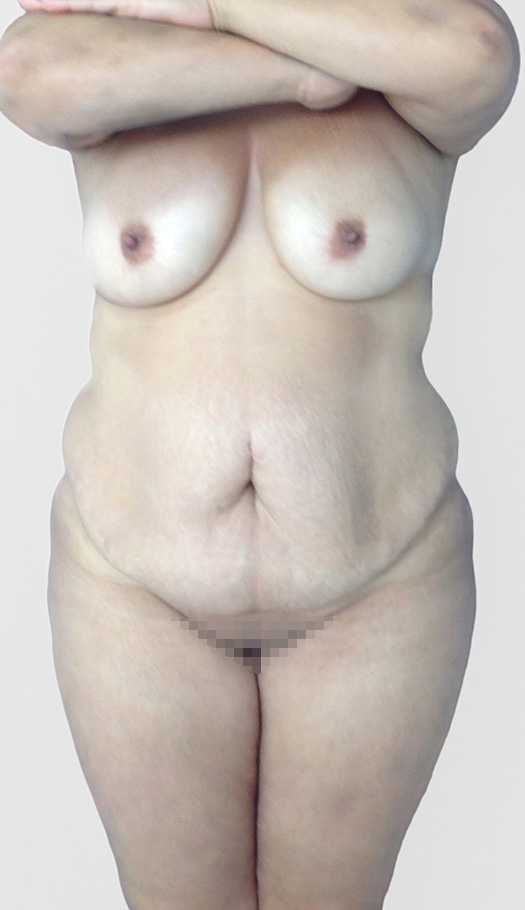
A tummy tuck can improve an individual’s overall appearance by removing the unwanted skin from the abdominal area. Although tummy tucks are usually performed for cosmetic purposes, some patients seek this procedure to improve other medical issues, including back pain, which can be caused by weakened or loosened abdominal muscles. At times, a tummy tuck can serve as reconstructive surgery.
What is a Tummy Tuck?
During this procedure, doctors tighten abdominal muscles that have been weakened, separated or loosened as a result of the fluctuation of weight or pregnancy. The abdomen is also reshaped and flattened by removing fat and skin that causes the belly to protrude. In some cases, a tummy tuck can even remove or improve the appearance of stretch marks located below the belly button.
The tummy tuck procedure is entirely different than liposuction. Liposuction is the removal of fat deposits through suctioning. However, combining these two cosmetic procedures can often provide more satisfying results.
Abdominoplasty is an invasive cosmetic surgery that cannot be substituted for exercise and regular dieting. Many patients choose this procedure after all other methods have failed and weight is relatively stable.
Typically, tummy tucks are more costly than liposuction and require a slightly longer period of recovery. To achieve long-lasting results, patients should maintain a healthy diet and regular exercise routines. This is a procedure that is available to both men and women in need.
Tummy Tuck Miami Candidates
The ideal candidate for a tummy tuck procedure would be a physically and emotionally healthy individual within 25 pounds of his/her recommended weight. It is also crucial that the individual is a non-smoker with realistic expectations. Women and men with excess loose skin and fat in the abdomen area can benefit and be great candidates for this procedure. Patients that still plan to get pregnant in the future should wait until they are done having kids. If you plan on losing extra weight in the future, you may want to hold off until having reached your desired weight. Abdominoplasty has been successfully performed on patients who have lost a significant amount of weight and whose skin has lost elasticity.
Tummy Tuck Miami
Before & After Pictures
EXPLORE PHOTO GALLERY
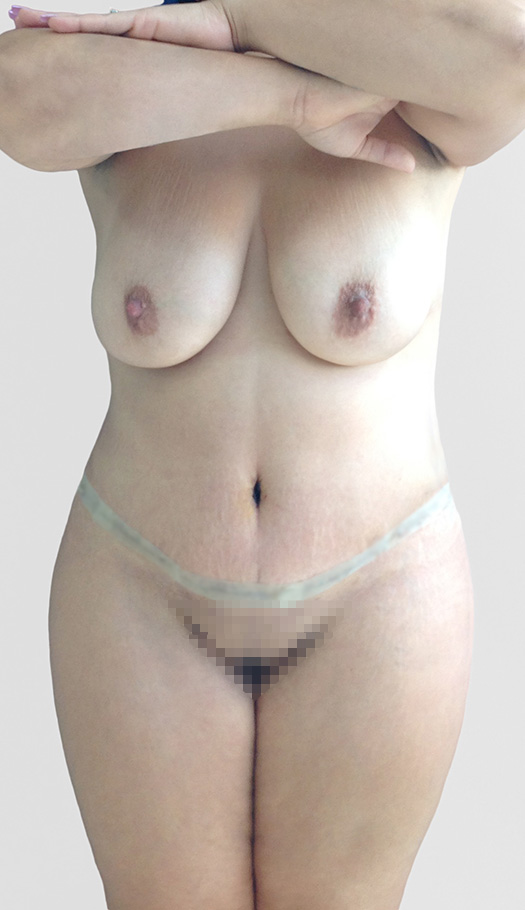
After
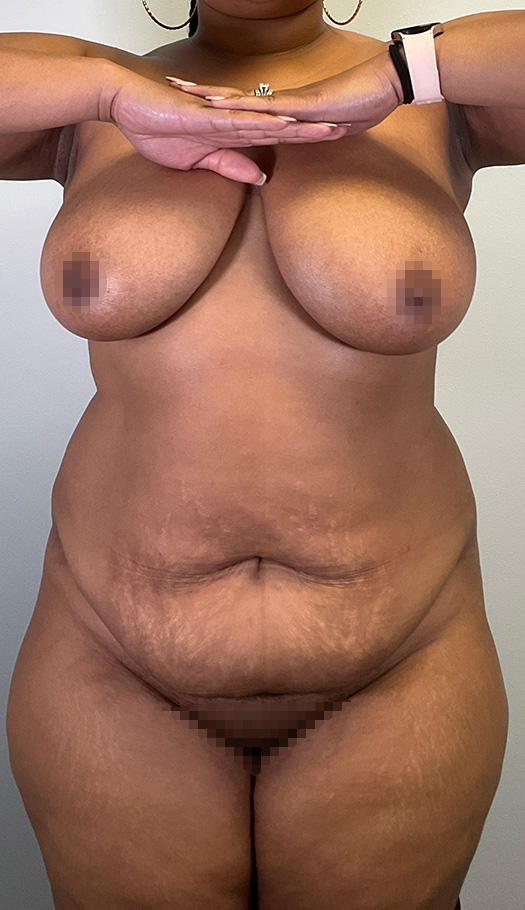
Before
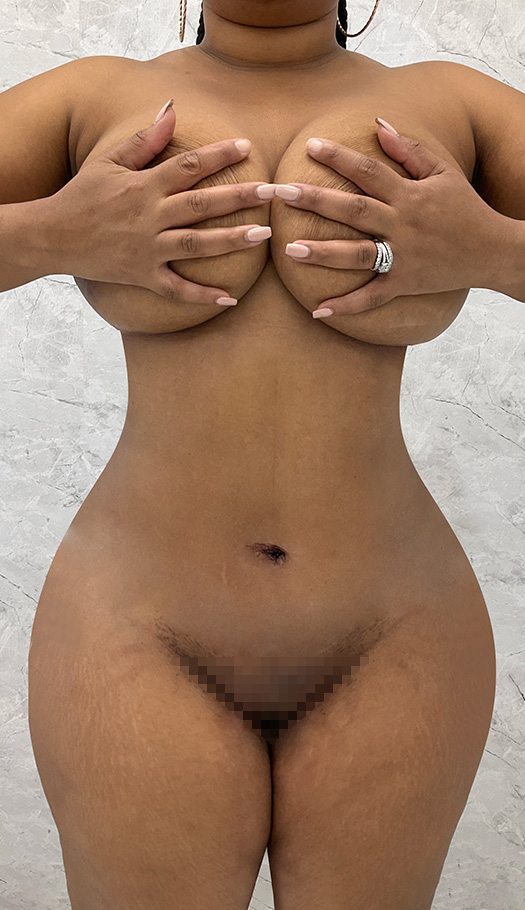
After
Who should avoid getting a tummy tuck?
Patients that are regular smokers or are frequently exposed to secondhand smoke should quit smoking or avoid smoke exposure at least one month before surgery and one month after. Smoking causes decreased blood flow which can cause many complications including; extended wound healing, infection, skin loss, increased scarring, among others.
Patients who plan on losing weight in the future should also avoid surgery since more weight loss can result in more loose skin. A tummy tuck surgery can be postponed until the individual has reached the recommended or desired weight for the procedure. Women who plan on having more children in the future should also wait. Getting pregnant after having an abdominoplasty can alter the results of the procedure.
The Tummy Tuck Procedure
There are various forms and techniques for the abdominoplasty procedure. The time of surgery depends on which type of tummy tuck you choose to give you the best results. A tummy tuck can take between 45 minutes and 3 hours. The time depends on the patient’s size and body constitution. The process involves several steps:
- General anesthesia is administered to the patients when they are taken into the operating room.
- The complete abdominoplasty uses a technique that requires two incisions. The first incision runs horizontally, from hip to hip, right on top of the pubic region. The length and size of the incision depend on the amount of skin removed and the anatomy of the patient. If the patient has excess loose skin around the navel, an additional incision will be made around the belly button so that extra skin can be removed, and the remaining skin is pulled up to create a flatter and tighter look.
- The muscles are then sewed together and tightened. That will make the waistline smaller and the abdominal wall much firmer.
- Once the excess skin is removed and the skin is tightened, the surgeon will create a location for the belly button similar to the one before surgery.
- Some stretch marks may be removed while remaining stretch marks will be improved and flattened. It is essential to be aware that some stretch marks can stay and scarring will also be present. Although you may want your scar to be gone after a few years, this isn’t always possible.
- Once the procedure has been completed, drainage tubes will be inserted under the skin to remove the buildup of fluid. Compression garments will most likely be placed around the operated area as well.
It is important to note that all types of tummy tucks may address issues patients have differently. Every procedure differs in recovery time and complexity. Therefore, your plastic surgeon will recommend the best surgical approach for your body.
TUMMY TUCK VS. LIPOSUCTION
It is common for the tummy tuck procedure to be combined with liposuction. During your initial consultation, your plastic surgeon will evaluate you and determine how much fat should be taken out according to your needs and desires. The first part of the procedure is the liposuction, where they take out excess unwanted fat from several areas of the abdomen and back. Once the liposuction is done, a partial or full tummy tuck will be performed, depending on the decision you have made.
Schedule A Free Consultation Today
Partial or Mini Tummy Tuck
A partial tummy tuck is targeted specifically at the surplus skin and fat deposits near the belly button. However, the belly button stays where it was. The incision for this technique is typically smaller than the incision of the complete tummy tuck, making recovery time significantly quicker. During this procedure, a small incision is made right on top of the pubic area. The extra skin is then removed, and the remaining skin is pulled together and reattached creating a smooth and tight look. This technique is most beneficial among patients that want to get rid of excess skin in the lower abdomen.
Circumferential Abdominoplasty
Another option patients have, which is slightly different than the traditional tummy tuck, is the circumferential abdominoplasty. This procedure is sometimes referred to as a “belt lipectomy” or “body lift.”
While the traditional tummy tuck only focuses on the abdomen, this procedure is aimed at correcting the back, hips, waistline, thighs, and buttocks as well. If there is excess skin on any of these areas that have lost elasticity, it will be removed. During this procedure, muscles can also be repositioned to create a firmer looking figure.
The first step in this procedure is creating an incision that runs along the waist so that excess fat and skin can be removed. Once all the unwanted skin has been removed, the lower and upper skin tissue will be joined together creating a smoother and tighter look.
Tummy Tuck Infographics
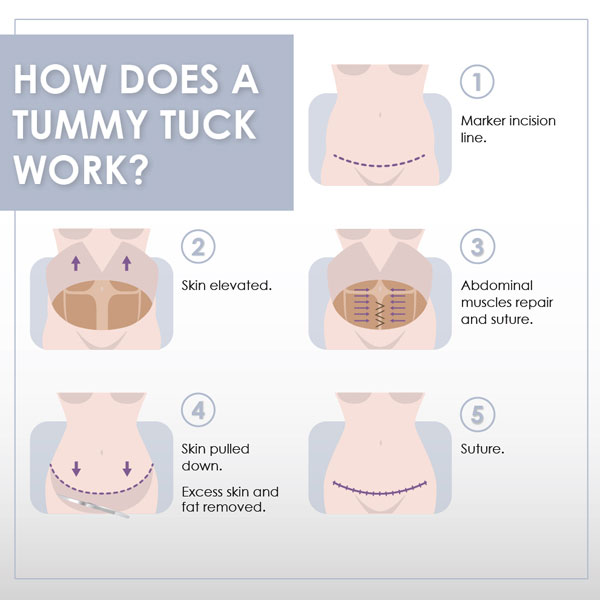

How to prepare for a Tummy Tuck?
Preparing your body for surgery is very important. Smokers must quit smoking several weeks before the scheduled surgery date. Cutting down on smoking is not recommended, since the chemicals in cigarettes slow down the healing and recovery process. Smoking also raises the chances for further complications. Your plastic surgeon will also provide you with a list of supplements and medications that you should stop or continue to take. Avoiding blood thinners such as Motrin and Aspirin is essential.
Maintaining a healthy diet with well-balanced out meals is also important. Your body needs the right nutrients to heal properly. Once you schedule your surgery, you should plan an extended recovery time. When it comes to your diet and weight, you should avoid any extreme diets. Rapid weight loss in a short period of time can lower your immune system, increasing the possibility of infection.
Preparations that should be made before your procedure:
- Arrangements for animal and pet care
- A comfortable bed with enough pillows to provide support
- Prescribed medications should be purchased before surgery
- Nightlights may be necessary to help you get around at night
- If there is anything you might need, make sure it is somewhere that you can reach it without having to extend your arms
- Loose, comfortable clothing should be accessible
- Have your movies, magazines, journals, and books ready and handy
- Wash your hair the day before surgery
- Buy the appropriate foods ahead of time
- Let your job know you will need at least two weeks off to recover
- Have a friend or family member nearby at all times
- Have your doctor’s phone number handy in case you have any questions, concerns, or emergencies
- Make sure you are resting near a bathroom
TUMMY TUCK RECOVERY PROCESS
First 48 hours
You must arrange transportation and care after your procedure. You will not be able to drive for the first few days, and you will need extra care for the first 48 hours. During your recovery period, you should attend regular post-op appointments with your plastic surgeon. Compression garments must be worn as told to reduce swelling and help the body adapt to the new shape.
Pain Management
Your doctor will prescribe you pain medication to relieve any discomfort you may have. It is normal for your stomach to feel tight and swollen. Wearing your compression garments will help the pain and recovery. Numbness of the skin around the incision and belly button is common. The drainage tubes will get rid of fluid build up after surgery.
physical activity
Patients should be aware that mood swings, depression, and hyperactivity after surgery is possible. After a severe operation such as this one, many changes in the body occur that take time to get adapted to. Movement and physical activity should also be avoided or at a minimum. With time, you will slowly fall into your regular routines.
Recovery Time
The time of recovery highly depends on the patient and the type of tummy tuck. Factors such as health, age, and skin elasticity all affect the time of recovery. Patients should take short walks around the house the day after surgery to make sure the blood is flowing. Standing up straight will not be possible for the first week or so. Patients should also avoid sitting for long periods of time. Activities such as lifting, bending down, and pushing should be avoided for the first few weeks. These movements can cause extra bruising and swelling. As time passes, your body will heal, and scars will begin to fade becoming less noticeable. Although scars will fade, they will not disappear entirely.
Tummy Tuck Surgery Case Results
Case 1: Full tummy tuck
Patient with loose skin who got a flat well defined abdomen after a full tummy tuck by Dr McDaniel.
Case 2: Standard abdominoplasty with BBL
Standard abdominoplasty after childbirth by Dr Zhong including belly button repositioning and more projection on buttocks.
Case 1
Case 2
Tummy Tuck Risks
Every surgery has its fair share of possible risks, complications, and side effects. After this procedure, it is common to experience pain, bruising, and swelling. Anesthesia sometimes causes side effects, infection, or bleeding. Pain should be expected, but your doctor will give you prescriptions for pain medication.
Soreness can last for up to a few weeks after the procedure. Numbness can last for up to a year and in some cases can be permanent. Some possible complications include poor healing, infection, and blood clots. Your doctor will provide you with information to help you avoid these complications.
After an extensive or full tummy tuck, tissue loss can occur along the incision. Patients that smoke or have diabetes may develop hematomas. That happens when drains are taken out, and extra fluid accumulates under the skin. This fluid can be removed with a needle in your doctor’s office.
TOMMY TUCK COST in Miami
The Tummy Tuck cost in Miami generally ranges between $3,500 and $10,000. The cost of the procedure varies depending on the state and city in which your procedure is performed. Other factors such as age, weight, and state of health may also affect the price. According to RealSelf statistics, the typical cost for this procedure varies from $3,350 to $12,875 with an average cost of $8,150. This cost is based on over 25K RealSelf patient reviews, and it usually includes anesthesia, facility fees, medications, and pre and post-op care.
If a patient is getting a tummy tuck for medical reasons, then insurance is likely to cover the costs. If it is being performed for cosmetic reasons, you will not receive help from your insurance.
Tummy Tuck FAQs
Most patients undergo this procedure after they give birth and don’t plan to have any more children. Also, if you expect to lose significant weight, you should wait until you have reached the desired weight. There is not an ideal age. As long as the patient is in good health and a good candidate for the procedure, they will have a good outcome.
A tummy tuck will address fat tissue mainly in the upper and lower abdominal area. It also helps detach anterior abdominal muscles and address saggy skin, stretch marks, excessive weight loss and stubborn fat deposits after pregnancy.
Some non-surgical skin-tightening approaches may be effective in some patients, including exercise. However, in most cases, a tummy tuck yields better results since these patients have loose skin folding over on itself. Loose belly skin can only be tightened with a surgical procedure.
A tummy tuck is not a weight loss plan. This procedure trims excess skin so you will probably weigh four to ten pounds less because of the skin that was removed. In other words, if you are close to your ideal weight but still have excess skin in the abdominal area, which cannot be corrected with exercise, you are a great candidate for a tummy tuck.
A tummy tuck will not remove all stretch marks, only those below the belly button. However, redundant abdominal skin can be removed with a tummy tuck, making stretch marks on the upper abdomen less noticeable. In short, this procedure can help improve the appearance of some stretch marks and eliminate others.
Absolutely! A tummy tuck will help remove excess loose skin.
Fat should not return unless you gain weight. Nevertheless, since many of the fat cells have been removed during surgery, the capacity for extra fat will be less. The skin and muscles will also stretch over time, but you will enjoy an enhanced body shape for several years.
Women that already had children generally need a full tummy tuck to tighten the stretched-out abdominal wall and remove excess skin. Only a smaller percentage of women qualify for a mini-tummy tuck when the loose skin is mostly on the lower abdomen.
It all depends on the kind of work you do. If there were no complications after surgery and you are sitting by your desk most of the time and your job doesn’t require heavy lifting, you may go back to work a week after surgery. However, if you undergo a major procedure, you may need two weeks to recover fully. That is a decision your doctor can help you with.
The risks of this procedure are minor, including issues with wound healing and scar asymmetry, fluid buildup, and numbness. There are also some severe but less common risks such as bleeding, infection, and blood clots.

